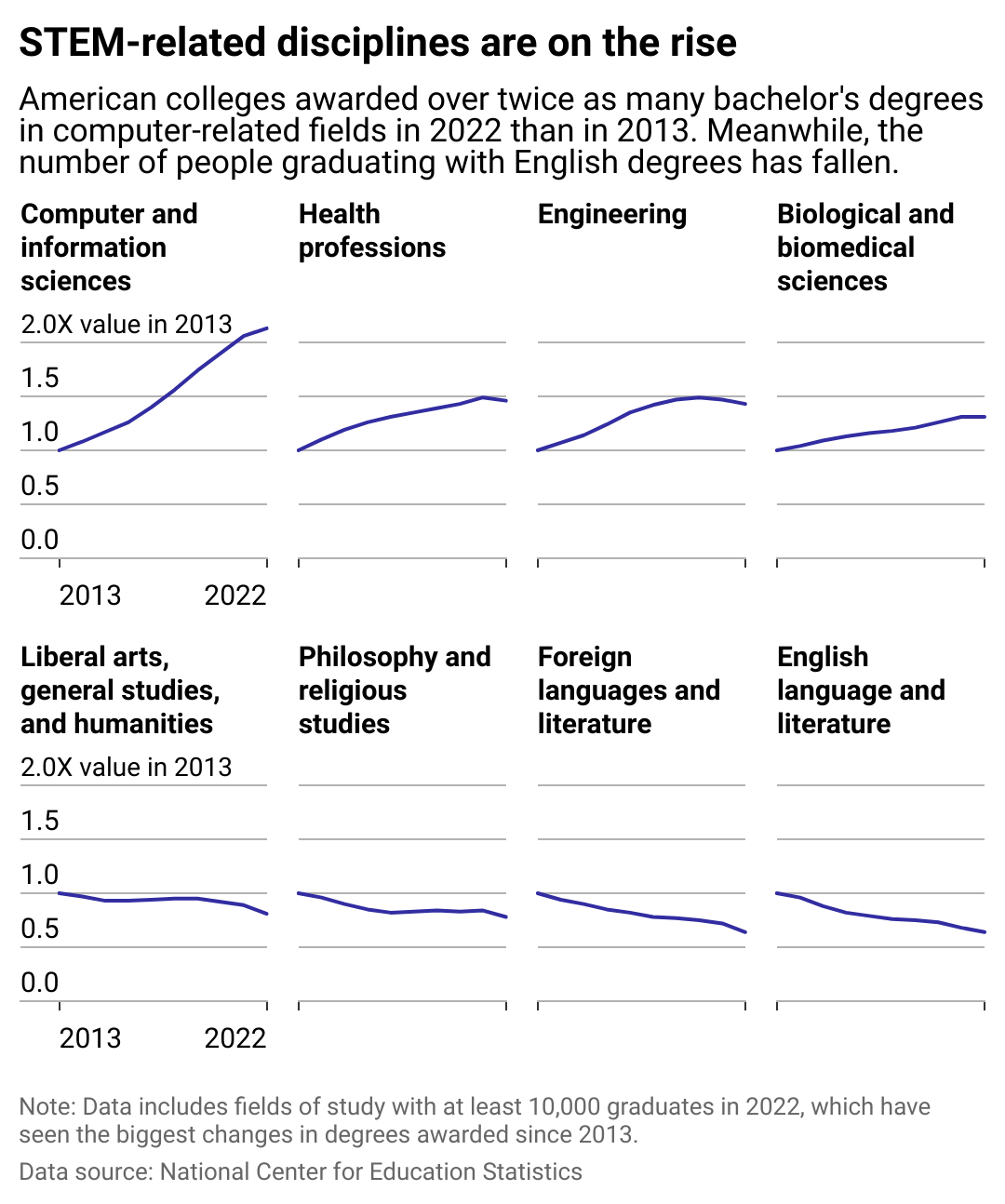STEM is the new liberal arts: The changing trends of college majors

Shutterstock // Gorodenkoff
STEM is the new liberal arts: The changing trends of college majors
Male teacher pointing at the screen, standing in front of students in a dimly lit classroom.
As the class of 2024 enters the job market, many graduates with degrees in STEM fields (science, technology, engineering, and mathematics) are about to find out if their majors will deliver on the promise of stable job prospects and financial security.
For at least a decade, technical degrees in STEM fields have led graduates to higher-earning careers than those with degrees in the liberal arts or humanities. Since 2009, full-time workers with STEM undergraduate degrees have consistently earned around 30-40% more than their peers with liberal arts degrees, based on Census Bureau data.
However, it has taken time for students’ courses of study to adapt to this trend. Between 2013 and 2022, bachelor’s degrees awarded by American colleges increased from about 1.85 million annually to just over 2 million. During this period, the number of STEM bachelor’s degrees rose by about 40%, while the number of bachelor’s degrees in liberal arts and humanities awarded per year fell by 14% during the same time period.
Though this increase coincides with a period of increased demand for programmers, the rising cost of college further increased the appeal of degrees that pay off financially. Data from the Census Bureau shows that workers aged 25-64 who studied engineering, computer science, and economics had median earnings of around $100,000 in 2022, while those who studied English, liberal arts, and history had median earnings of around $65,000 to $75,000.
According to the College Board, the average net cost of going to a four-year college, excluding housing and food, has risen to roughly $11,000 annually at public schools and just shy of $42,000 at private schools. Federal Reserve data shows that households with student loans owed a median of $24,500 in 2022, up 13% from 2013. A typical student who took on federal loans owed an average of $37,000 in 2023, up from $26,000 in 2013.
Learner analyzed data from the National Center for Education Statistics to see which college majors were growing the fastest and how these increases relate to current and upcoming trends in the job market and tuition costs.
![]()

Learner
Computer science and health care are on the rise
A chart showing how the number of bachelor’s degrees issued in the US, per year, has changed since 2013. The number of computer science degrees awarded has doubled, while number of English degrees issued has fallen by a third.
Shifts in college majors tend to mirror shifts in the job market. According to the Bureau of Labor Statistics, the number of people working in health care support roles rose by over 70% between 2013 and 2022; those working in computer and mathematics rose by 35%. Both fields far outpaced overall employment growth, which was around 12% during the same period.
The number of degrees awarded in computer fields has doubled since 2013, making this the fastest-growing class of bachelor’s degrees. Not only are all five of America’s most valuable companies in the tech space, but workers running data analyses or building websites and apps are now standard in companies across sectors and disciplines.
Health care fields are the second-largest-growing group of college majors. In 2022, American colleges awarded 264,000 bachelor’s degrees in this category, up from 180,000 in 2013.
Some of the growth aligns with an aging America, as baby boomers retire and the demand for health care workers increases. The spike in health care degrees also reflects a push by state governments and the health care industry to train and hire better-credentialed workers. Since 2010, the share of registered nurses holding bachelor’s degrees has risen from 55% to 67%.

Shutterstock // djrandco
What does the future hold for STEM graduates?
A young woman smiling, shaking man’s hand in an office space.
Projections by the BLS indicate that current labor market trends will continue through 2032, with health care support and health care practitioner jobs being the first- and third-fastest-growing occupational groups, growing by 15.4% and 8.0%, respectively. Occupations in computer science and mathematics are expected to be the second-fastest-growing group, with an anticipated rise of 15.2%.
The short-term outlook for computer science graduates seeking entry-level positions, however, is rather bleak. Many big tech companies have recently announced layoffs. The Wall Street Journal reports that the tech sector added just 700 jobs on net in 2023, down significantly from 267,000 jobs added in 2022. Citing the rise of artificial intelligence, firms are recalibrating as this new technology reshapes the job landscape.
Current AI systems are especially good at enhancing the productivity of computer programmers, giving firms a reason to believe they can get more out of their existing workers. Looking ahead, a survey conducted by the National Association of Colleges and Employers shows that firms expect to hire 5.8% fewer people this spring compared with the year earlier. But with change may also come new opportunities. Some 11% of all tech job listings in the past several months have been for AI and related skills, according to WSJ, suggesting that more widespread use may also necessitate specialized talent.
The rising cost of college has made education more of an investment than it was in years past. College students are taking note, and in the next decade, trends in degrees attained might look very different.
Story editing by Alizah Salario. Copy editing by Paris Close. Photo selection by Ania Antecka.
This story originally appeared on Learner and was produced and
distributed in partnership with Stacker Studio.